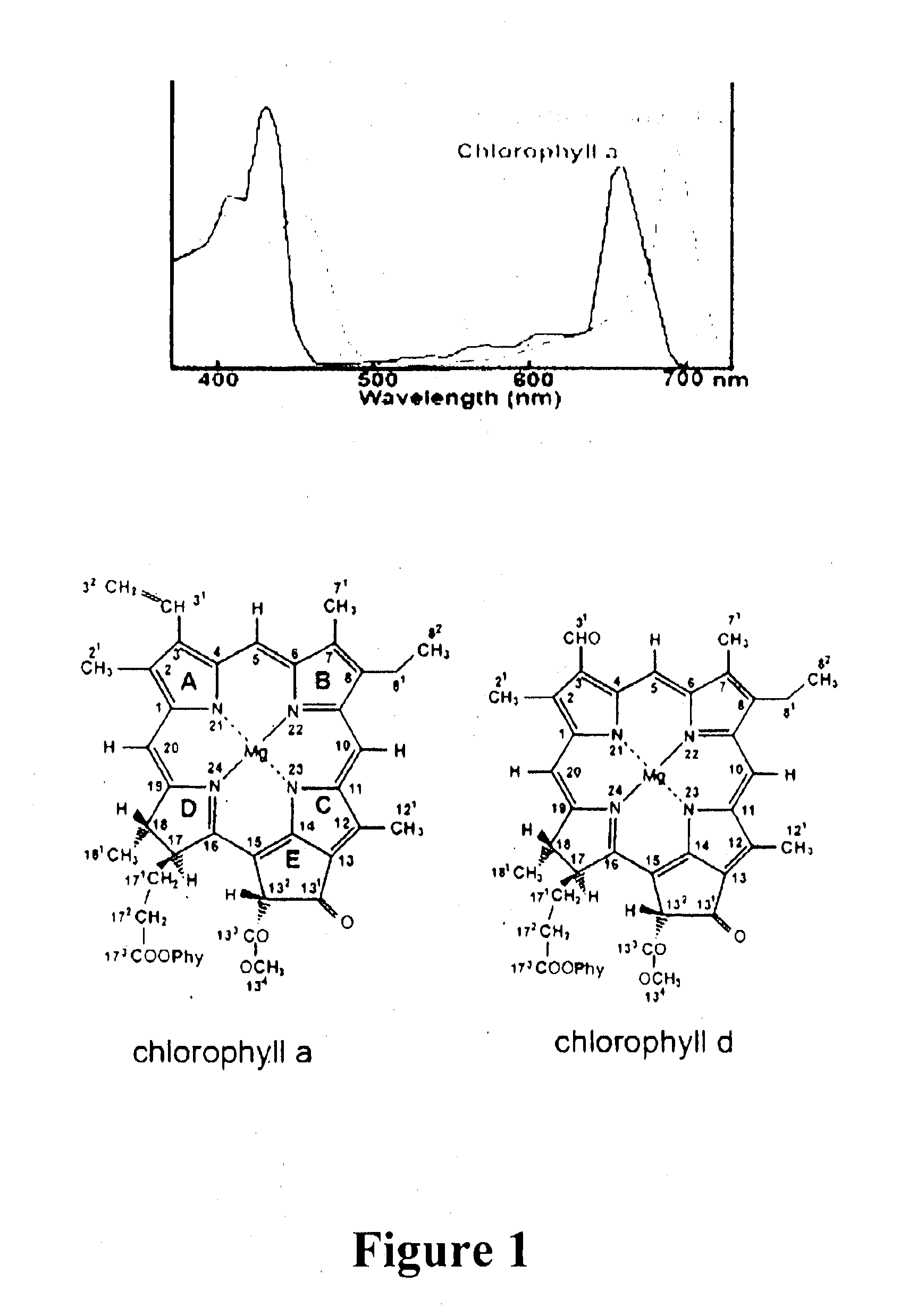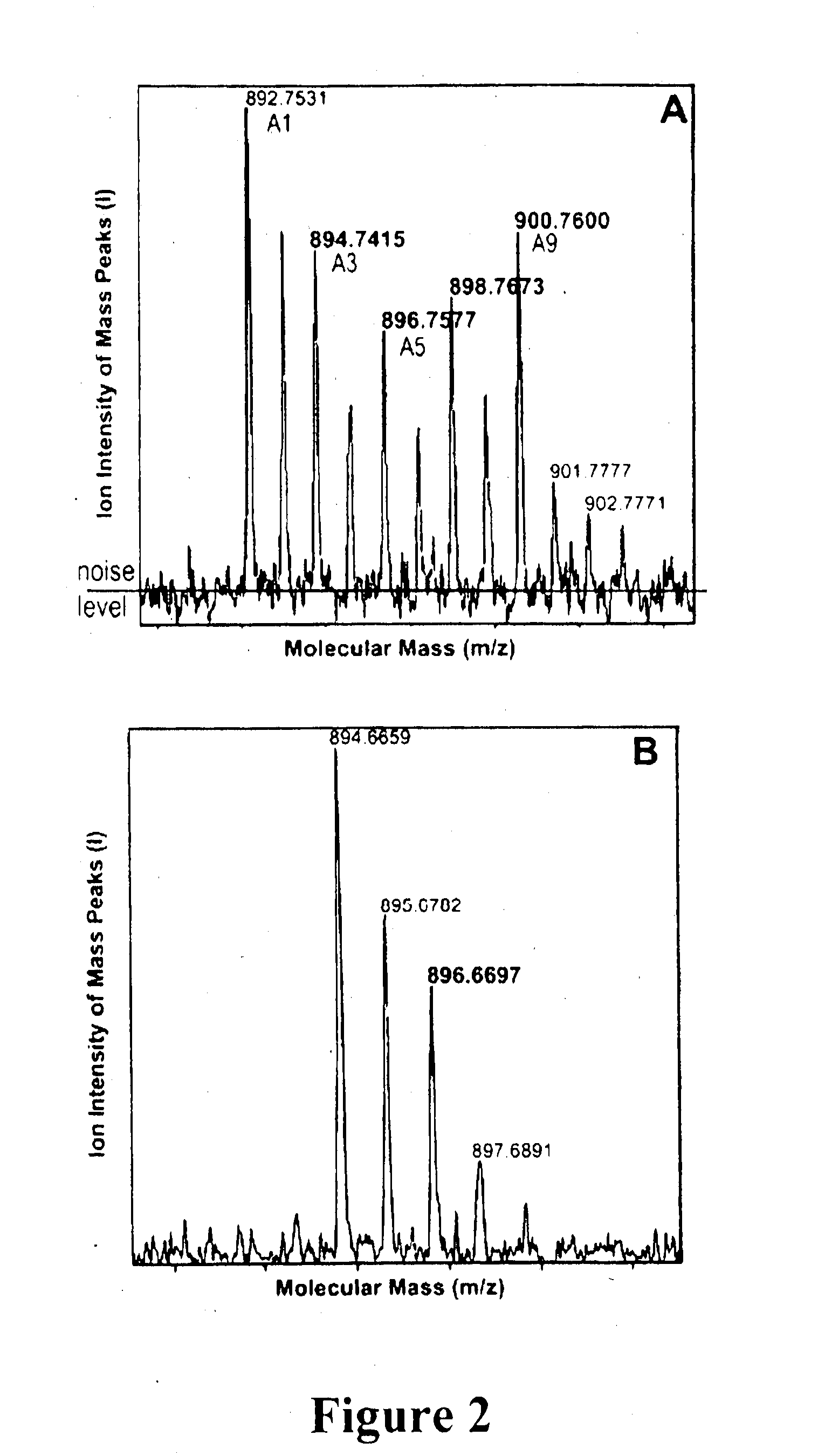Gene Constructs Comprising Nucleic Acids That Modulate Chlorophyll Biosynthesis And Uses Thereof
a technology of nucleic acids and genes, applied in the field of agriculture, industrial bioprocessing and diagnostics, can solve the problems of limiting the applicability of the possibilities described by swingley et al., limiting the utility, and limiting the application, so as to facilitate agrobacterium-mediated integration, minimize the effect of squelching effects, and enhance the ability of a transformant organism
- Summary
- Abstract
- Description
- Claims
- Application Information
AI Technical Summary
Benefits of technology
Problems solved by technology
Method used
Image
Examples
example 1
Mechanism of Chlorophyll d Biosynthesis
[0248]This example demonstrates that Ch1 d is synthesized from Ch1 a, and that the C-31 formyl-group oxygen of Ch1 d utilizes an oxygenase enzyme, such as by 18O labelling and mass spectrometry to follow chlorophyll biosynthesis in the exemplary cyanobacterium Acaryochloris marina.
1. Experimental Procedures
[0249]a) Culture Conditions and Growth Rate
[0250]Freeze dried 1 ml KES-sea water medium was resuspended in 1 ml H218O (98% 18O; Marshall Isotope, Israel) and inoculated using 100 μl of fresh Acaryochloris marina (MBIC11017) culture having an absorbance at 710 nm (Qy transition) of 1.0. The cultures were incubated for 24, 45, 65, 95 and 115 hrs under continuous white light illumination having an intensity of 30 μM photons M−2 s−1. Cells were maintained in suspension by continuous shaking at about 100 rpm.
[0251]A. marina MBIC11017 culture (25 ml) having an absorption maximum at 710 nm of 0.2 was grown in ASW K+ES medium, in the presence of 50%...
example 2
Substrate Requirements of Ch1 d Synthase
[0283]This example provides evidence that chlorophyll d synthase is a dioxygenase distinct form CAO-type enzymes.
1. Experimental Procedures
[0284]a) Culture Conditions and Growth Rate
[0285]A. marina cells were cultured under white light at 22° C. with gasification by bubbling air, or air mixed with gaseous carbon monoxide [about 1:1 (v / v)], or nitrogen gas. Chlamydomonas reinhardtii cells were cultured under the same conditions as a control.
[0286]a) Pigment Extractions and Analyses
[0287]A long needle-syringe was used to sample cells, and pigments were extracted from cells as described herein above using methanol, HPLC analyses were also as described above, except that the Agilent 1100 series HPLC system was employed with the reverse phase C18 column being equilibrated and run with 100% methanol solvent.
2. Experimental Results
[0288]In contrast to A. marina, cells of C. reinhardtii comprise Ch1 a and Ch1 b. It is known that formyl group at the C-...
example 3
Isolation of Gene Encoding A. marina Ch1 d Synthase
[0297]This example provides an isolated nucleic acid encoding Ch1 d synthase of a cyanobacterium, A. marina.
[0298]a) Isolation of Nucleic Acids Encoding Cytochrome P450 Family Proteins
[0299]From the genome sequence of A. marina provided by Swingley et al., Proc. Natl. Acad. Sci. (USA) 105, 2005-2010 (2008), eleven gene loci were selected that encode putative cytochrome P450 oxygenase enzymes. Of these eleven gene loci, six were not present in the Salton Sea strain of A. marina, as determined by DNA hybridization, and were discarded on the basis that Ch1 d synthase is ubiquitous in Ch1 d-producing strains of A. marina. Thus, five gene loci were identified as putative Ch1 d synthase-encoding genes from this analysis: AMI—0606; AMI—0824; AMI—3563; AMI—4161; and AMI—5780. The sequence at gene locus AMI—3563 is not closely related to the sequences of cytochrome P450 oxygenases from other cyanobacteria.
[0300]Total ...
PUM
| Property | Measurement | Unit |
|---|---|---|
| Fraction | aaaaa | aaaaa |
| Fraction | aaaaa | aaaaa |
| Fraction | aaaaa | aaaaa |
Abstract
Description
Claims
Application Information
 Login to View More
Login to View More - R&D
- Intellectual Property
- Life Sciences
- Materials
- Tech Scout
- Unparalleled Data Quality
- Higher Quality Content
- 60% Fewer Hallucinations
Browse by: Latest US Patents, China's latest patents, Technical Efficacy Thesaurus, Application Domain, Technology Topic, Popular Technical Reports.
© 2025 PatSnap. All rights reserved.Legal|Privacy policy|Modern Slavery Act Transparency Statement|Sitemap|About US| Contact US: help@patsnap.com



